Thursday, January 5. 2017
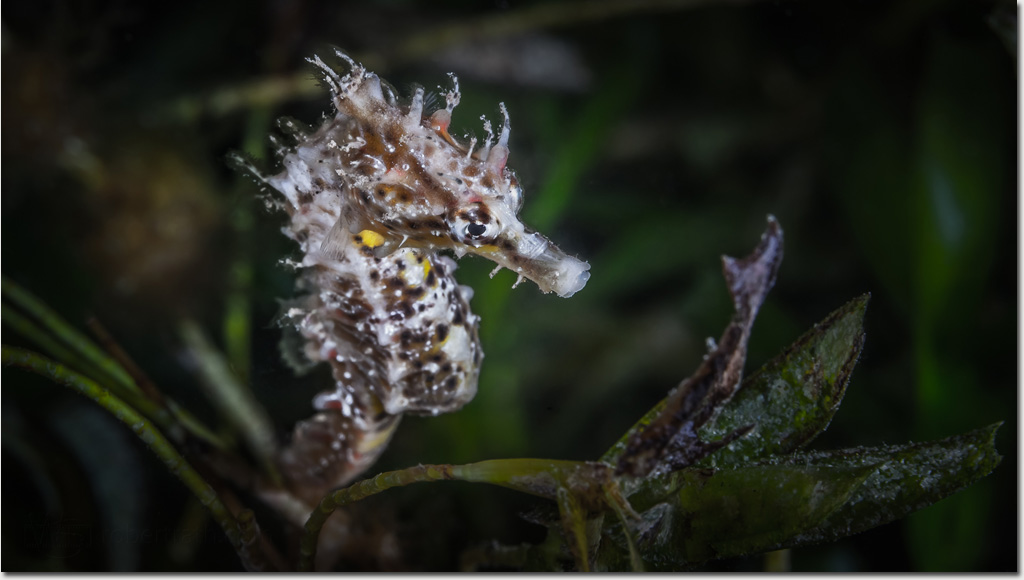
What a super cute way to herald in a New Year of diving; my first every sighting of a short-head seahorse, Hippocampus breviceps at Rapid Bay.
There is no reason why I should not have seen a seahorse under Rapid Bay Jetty in the hundreds of dives I have enjoyed here. I just haven't. Even my dive buddy Alexius had never seen a short-head seahorse here and he is one of the best critter spotters I know.
Actually this little guy was under the new Jetty which has a different kind of benthic structure. More seagrasses and less algaes so maybe that has something to do with it.
Perhaps I will spend a little more time exploring the new Jetty from now on. Who know what surprises await.
Photo: Robert Rath, 'Super Cute Surprise' 1/160s f/18 ISO320 100mm
Tuesday, January 3. 2017
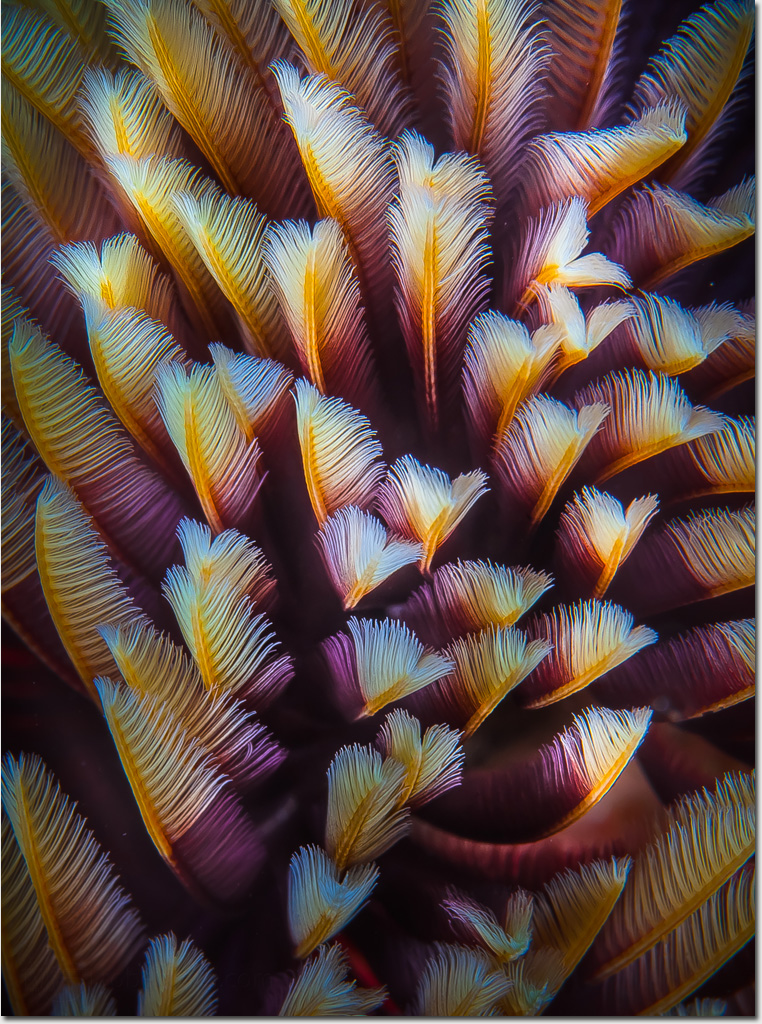
Last night was my first night dive for 2017. In fact it was my first dive for the new year and the conditions were perfect.
The evening star and a waxing crescent moon shone down on the water as we slipped below the surface. To the fishers on Rapid Bay jetty above it must have seemed like some mini apocalypse with our dive lights blazing and strobes firing. To the critters we were diving with most seemed unperturbed by our roving light show though I'm sure we were asked once or twice to turn our lights down or stop shining them in faces!
Despite the lovely conditions we did not see much variety in critter life so it was a dive to mostly enjoy being underwater again. Hopefully just the first of many for 2017.
One critter I always like seeing and photographing is this feathery looking thing. It is actually a worm called the Southern fan worm Sabellastarte australiensis. As those soft feathery appendages wash around in the current and surge you can never be sure just what the camera might capture the instant those strobes fire.
Photo: Robert Rath, 'Aquatic Feathers' 1/160s f/18 ISO320 100mm
Monday, January 2. 2017
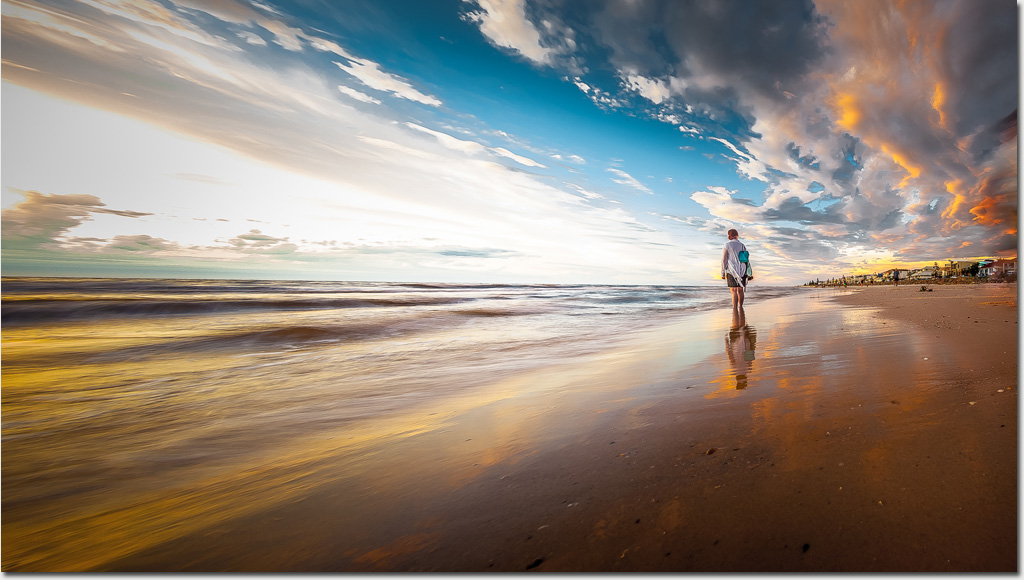
When the sunset plays the game of pretending to be over it pays to stay a while, to look up, to look around and to look behind.
Sneaking up from behind, the clouds, now struck with the sun's golden receding light, have become a new source to colour the world before twilight takes hold.
I wonder how many people missed it, the sun a while gone, giving attention back to evening meals, books or to a different kind glow from their coveted devices.
When it comes to sunsets and twilight it pays to stay a while and look around lest you miss something special.
Photo: Robert Rath, 'Sneaking Up From Behind', 1/2s f/14 ISO160 15mm
Wednesday, December 28. 2016
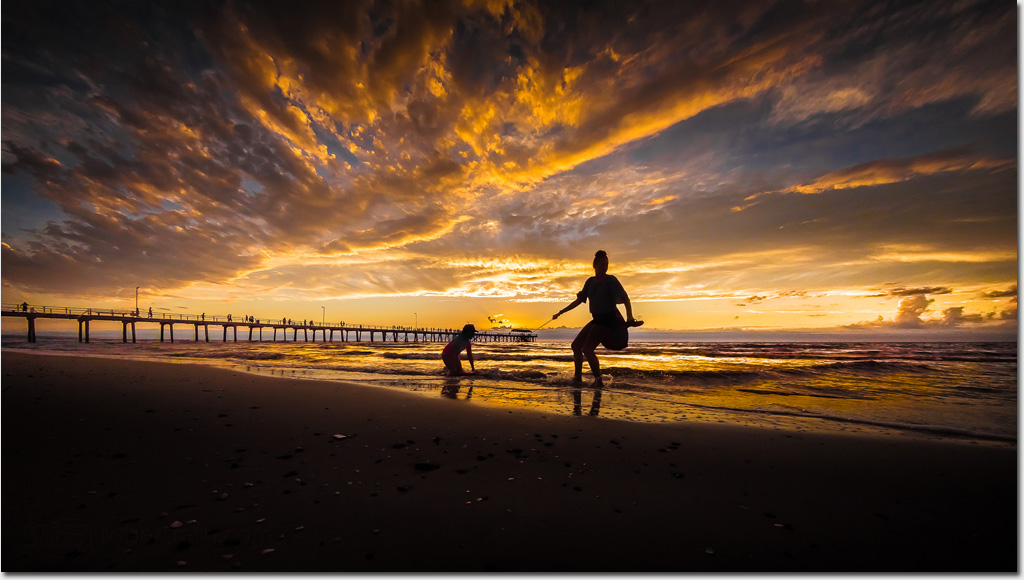
It has been way too long since I ventured down to our local beach to take in the salty sea air, wet sand between my toes and a gorgeous Henley Beach sunset. Even longer since I captured one.
With Adelaide's current crazy post Christmas weather, ie 40 degrees one day and 20 degrees the next, we have been getting some pretty amazing cloud formations and some gorgeous sunsets. I had a pretty good clue that tonight was going to be one of them as Jennifer and I headed down to the beach close to sunset.
A lesson I never seem to learn is to give myself time to find parking, especially during holidays on warm balmy evenings! We found a park eventually but by the time I got set up on the beach I got five shots before the sun disappeared for the night behind the cloud-bank on the horizon. Luckily for us that was just the start of the show, not the end.
For the next 30 minutes we watched the clouds above us, and in every direction to the horizon, capture the sunlight refracted, bent then diffracted through the Earth's thin atmosphere creating a stunning ever changing patchwork of golden tones. I really did not know which direction to point my camera in. It was spectacular across the entire sky.
Resorting to an old favorite view I pointed the camera out to sea and towards the jetty and waited. To my delight this young girl dragging a small boy though the baby surf made this another Henley Beach moment.
Photo: Robert Rath, 'Henley Beach Moment', 1/640s f/11 ISO160 15mm
Monday, December 19. 2016
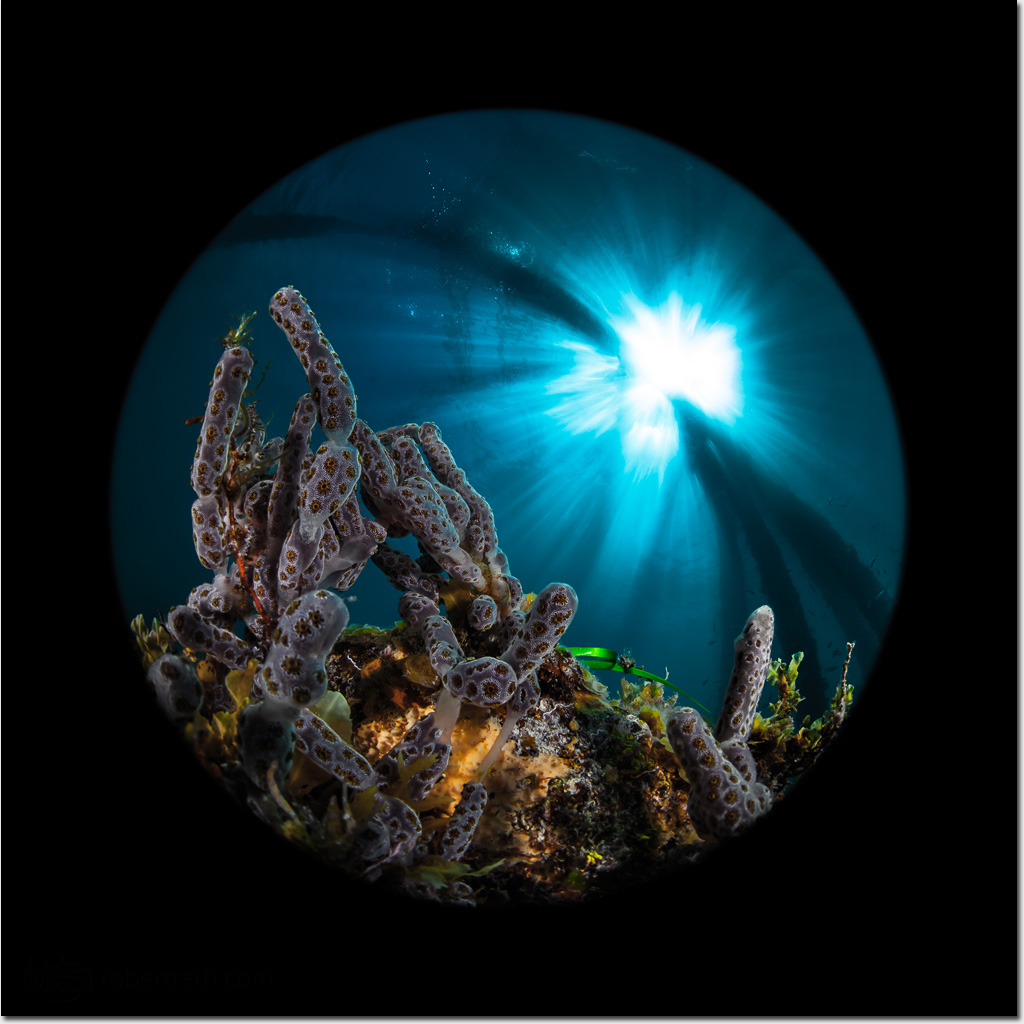
Perceptions are everything when it comes to seeing the beauty in our undersea landscapes but as we are not aquatic creatures we have our limits.
The colonial ascidians in the foreground are centimeters from the camera while the sunburst through the jetty structure above is more then ten meters away at the surface.
As a diver an image like this is impossible to see and nearly impossible to visualize however though the fish's eye it just might be close to the mark.
It might not be possible to see the world beneath Rapid Bay Jetty as a fish might but at least we can try.
Photo: Robert Rath, 'Through the Fish's Eye', 1/160s f/14 ISO160 8mm
Sunday, December 11. 2016
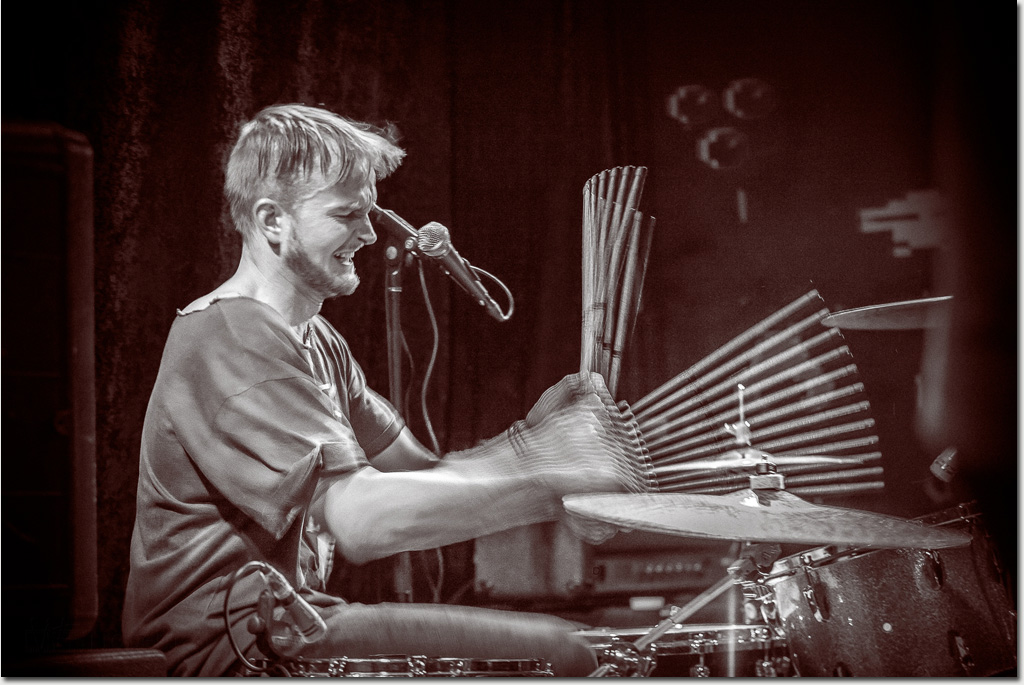
I had the pleasure last night of meeting the guys from Adelaide indie rock band Neon Tetra at Jive on Hindley Street and taking in the launch of their new single Memoriam.
Despite the challenging lighting I did manage to capture a handful of moments of the band in full stride.
Here, drummer Oscar Westell lays down the rhythm in superb style.
Photo: Robert Rath, 'Drumming in Memoriam', 1/25s f/2.8 ISO2500 100mm
Saturday, December 3. 2016
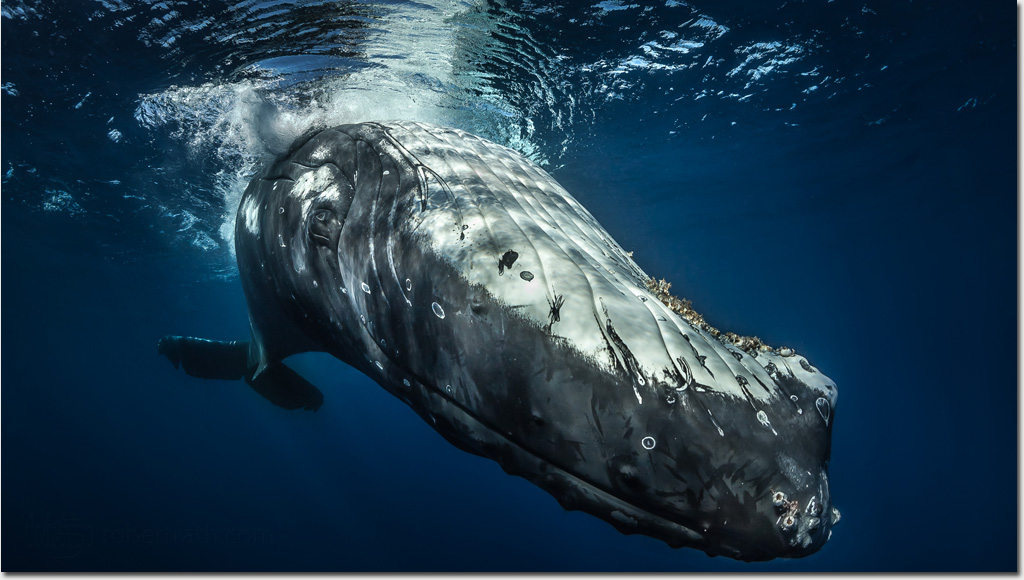
Downside upside downside up .... It's quite irrelevant to a whale's watery realm.
Meeting George this year in Vava'u, Tonga, was one of the most extraordinary moments of my life and has set things in motion I could never have envisioned.
I have already written about George and my first encounter with him in an earlier post. I've recalled how he terrified me, how he delighted me, captivated me and played with me. I have described how he lifted me gently out of the water, rolled me over and back in, then belly-rubbed me as he swam by.
George left me overwhelmingly wanting to not only share my experiences and my images, but also to encourage others to travel to Tonga. I want everyone to swim with these beautiful humpback whales and come back with their own experiences to share.
Since meeting George and the humpback whales of Tonga, I've felt a calling to do more for their cause and our marine environment. Perhaps I've already inspired others through my images and my writing. I hope so.
Photo: Robert Rath, 'Downside Up', 1/800s f/7.1 ISO160 15mm
Sunday, November 27. 2016
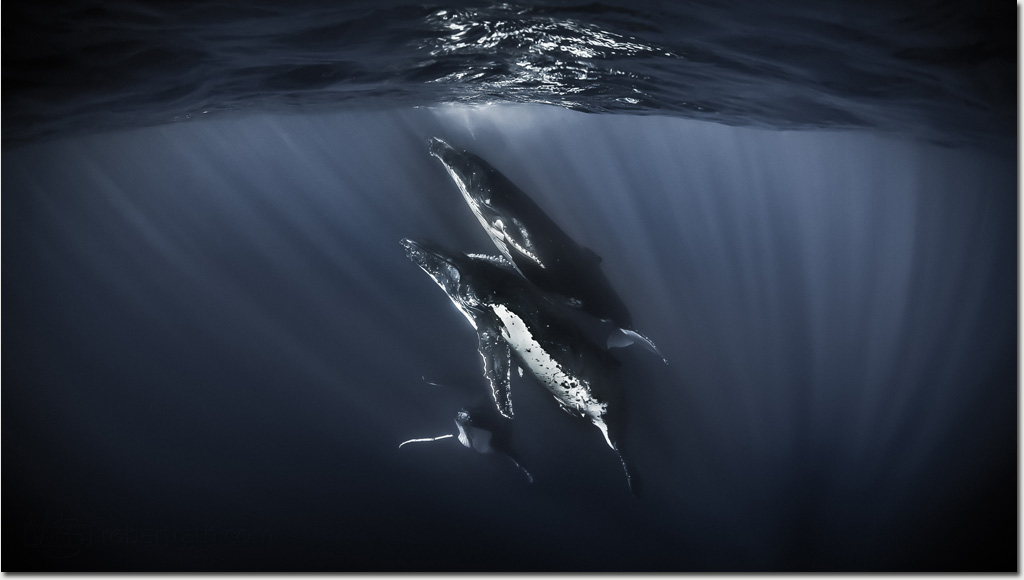
Or fours, or fives, or ... in fact this year has been the most extraordinary adventure for me.
I clearly remember these three male humpback whales during my recent visit to Tonga.
They were showoffs! How they came close enough to say 'look at us' but stayed far enough away to remain aloof.
They played games with each other staying just out of reach making fun of our inability to keep up or to move with their agility and grace.
They showed affection to each other with indifference to our presence.
They reminded us that this was their world and we were only welcome by their choosing.
The simply truth that they choose to be with us at all is something amazing and still fills me up with gratitude.
Looking back at my visit to Vava'u this year I am reminded how deeply my experiences with these beautiful whales has moved me.
Thank you Tony and Darren for the awareness and the inspiration.
Thank you Liam for making it real.
I am really looking forward to returning.
Photo: Robert Rath, 'Good Things Come In Threes' 1/200s f/6.3 ISO320 15mm
Monday, November 21. 2016
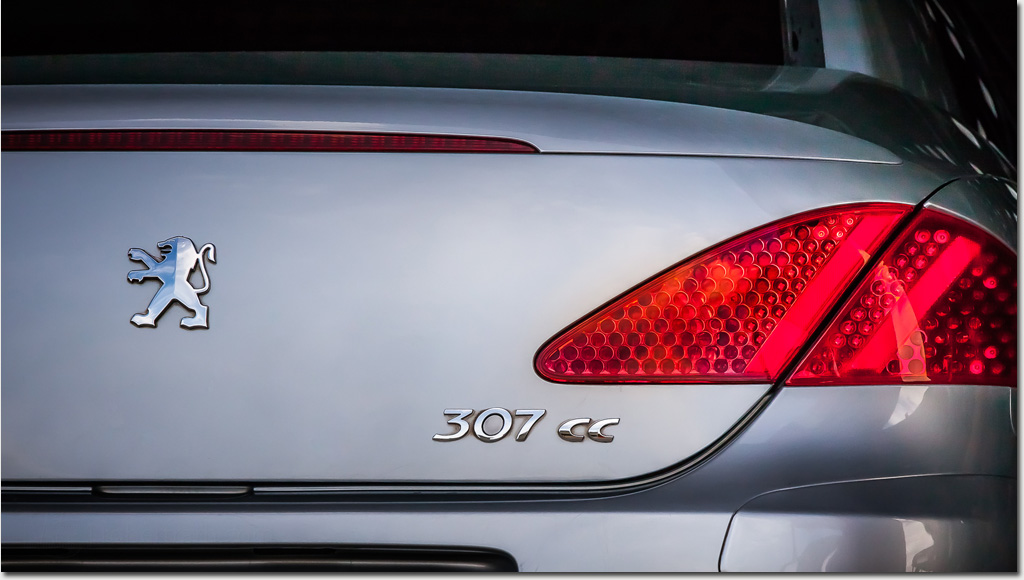
I've recognised that famous Lion logo since before I can remember, well before I knew what it meant.
Somewhere in my history though that logo become a name and that name became a nation's automotive pride, Peugeot.
Growing up in Australia meant being steeped in Australian car culture where you either lived, fought defended or died in the Holden tribe, or in the Ford tribe and your tribe was almost always the one that you parents came from.
There were of course other car manufacturers out there but they belonged to 'other' people.
It did not take me long though to realise just how parochial this attitude was, learning about the great car manufacturers from all over the world.
The french cat however eluded my attention for years hiding in plain sight, stalking me and waiting for the right moment to pounce.
Now that I have finally noticed, I'll be spending a little more effort discovering Peugeot's French heritage from humble beginnings over 200 years ago.
Photo: Robert Rath, 'The French Cat' 1/4000s f/7.1 ISO1000 200mm
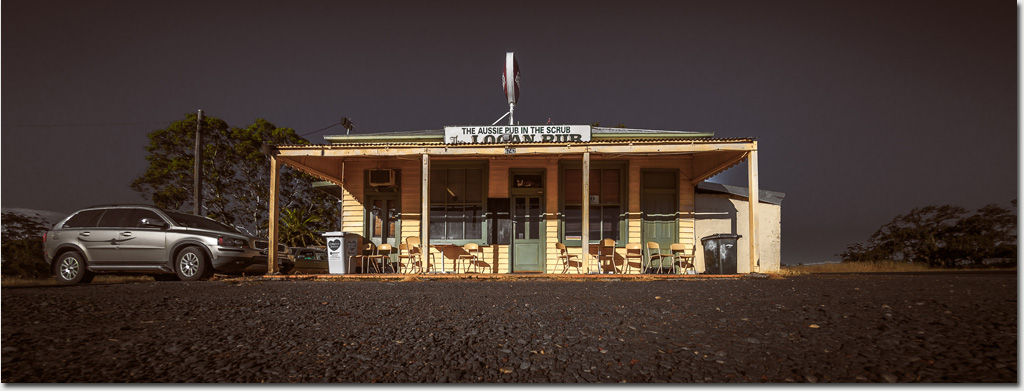
We spotted the Logan Pub on our way from St Arnaud to the Wehla Conservation Reserve and I made the mental note, 'I must photograph this pub on our way back'.
The sun was low and the light had that soft afternoon glow when we headed back to town and there it was again, the 'Aussie Pub in the Scrub'.
What was supposed to be a five minute break in our trip to capture some images turned into an unplanned session in the bar.
We met some interesting locals and a not so local a roving shearer from Glen Rowan with his own story to tell.
Reluctantly we had to leave before we would have liked but will keep fond memories of quirky locals, life-rich characters and the charm of a quaint little pub on its own in the middle of Central Victorian nowhere!!
Photo: Robert Rath, 'The Aussie Pub in the Scrub' 1/320s f/11 ISO100 15mm
Wednesday, November 16. 2016
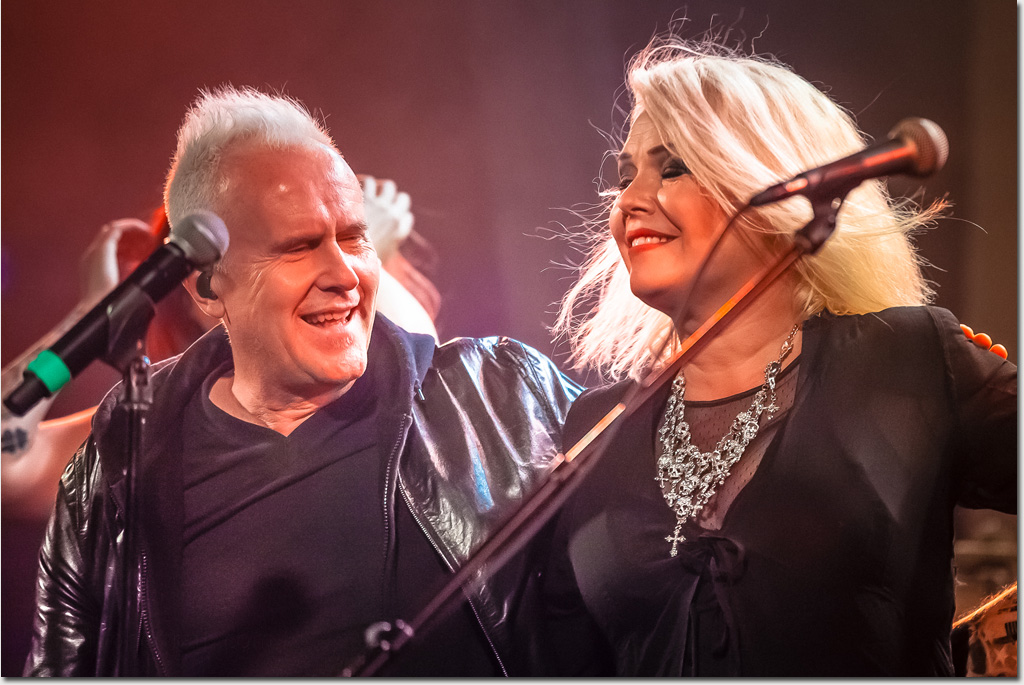
A long time ago in a world far, far away two musicians were making waves amid the wonderful new sounds being created in the 80's music scene.
For me the songs and sounds of Howard Jones captured my imagination and resonated with my hopes, fears and dreams. For many of my friends the rockier, rawer sounds of Kim Wilde were centre stage in their listening lives.
All this time later I find my self experiencing the extraordinary privileged of finally seeing Kim and Howard on stage together.
All the while I'm singing a Howard Jones 80's hit, 'Like to Get to Know You Well'.
Photo: Robert Rath, 'Like to Get to Know You Well' 1/200s f/2.8 ISO2000 200mm
Tuesday, November 15. 2016
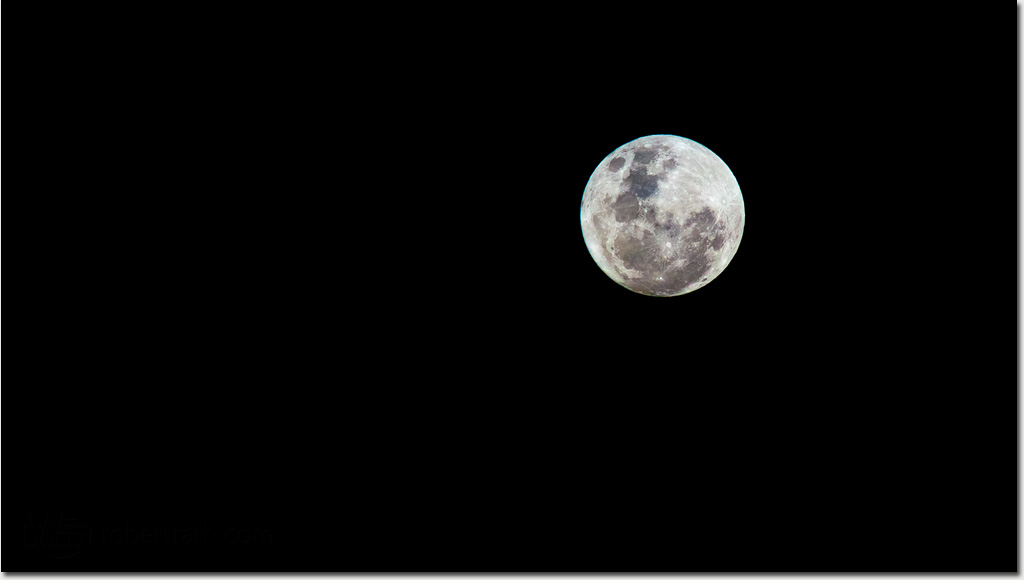
There was an amazing amount of media hype leading up to last night's Supermoon.
From out of nowhere came hundreds of experts espousing facts and figures.
There was talk of the best vantage locations, there were strong suggestions that you just can't miss it, the likes of which will not been seen again for another ... years!
Then out of the woodwork came the wet blankets calling us all sheep for being led by the hype to stand out in the cold evening to see this 'amazing' Supermoon for ourselves.
I'm no fan of over-the-top hype but in this case I think it was fantastic how so many people took notice, took the time and took photographs last night.
Our moon is one of the most beautiful objects in the night's sky regardless of its phase or size and if takes a heap of Supermoon hype to draw attention to it, that can only be a good thing.
Photo: Robert Rath, 'Mooning Out on the Hype' 1/200s f/9 ISO160 300mm
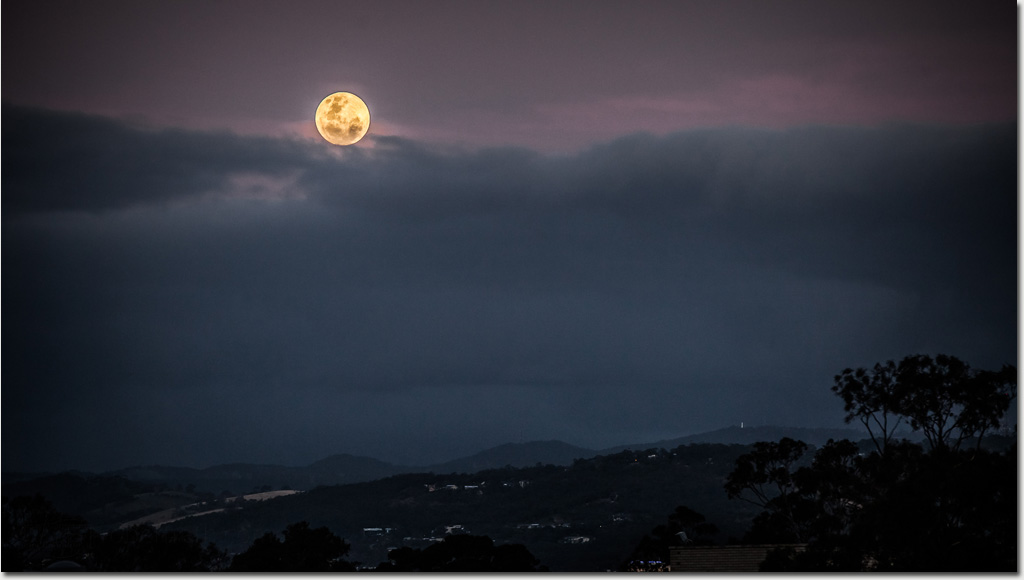
The moon was magnificent this evening, but not to start with.
The plan was simple; ... find a place where the moon will appear on the horizon of the Adelaide hills so as to silhouette the white tower of the Mount Lofty scenic lookout.
Google maps is a wonderful tool but finding line of clear sight vantage points is not one of its strong points but with a little creativity I managed to set up my tripod balanced on the edge is of multi-story car park with a tiny windowed view mostly encumbers by local trees.
As nature always has the last say the clouds stayed stubbornly on that grey horizon delaying the moon's 'Supermoon' appearance until it had crested both.
Photo: Robert Rath, 'Supermoon on the Grey' 1/320a f/4.5 ISO640 200mm
Saturday, November 12. 2016
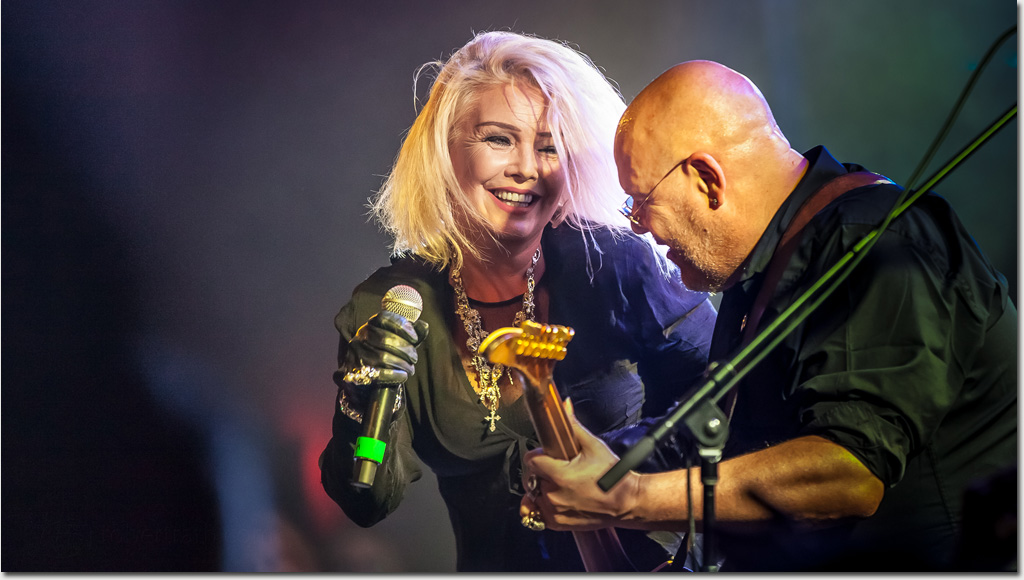
Who'd have thought I'd be kicking back and enjoying rocking to Kim and Ricky Wilde 35 years on!
As much as I loved many of Kim Wilde's songs I would never have called myself a fan so I would never had found myself here without just a little encouragement.
Once I discovered she was on stage with her younger rocker bother Ricky, the show took on a whole new meaning!
... if only Marty had been up there too!
Photo: Robert Rath, 'Sibling Love' 1/640s f/2.8 ISO2000 200mm
Monday, October 31. 2016

So it's Halloween and a time when stranger things somehow seem just a little more normal.
On the other hand there are some normal things which being somewhere they are not supposed to be seem downright strange, even disturbing.
We came across this discarded doll on the road recently while walking into Neiafu and as innocent as a lost toy might be I felt a strange chill as I lay in the middle of the road to capture this image.
The lack of clothes, the grubby grimy appearance, those purple eyebrows and other pen marks all made for a creepy scene I wondered if I should even be photographing.
I was so relieved to walk away and leave stranger things lie.
Halloween or not, give me pumpkins, black cats, ghosts, skeletons or witches any day.
Photo: Robert Rath, 'Stranger Things' 1/800s f/2.8 ISO160 50mm
Saturday, October 29. 2016
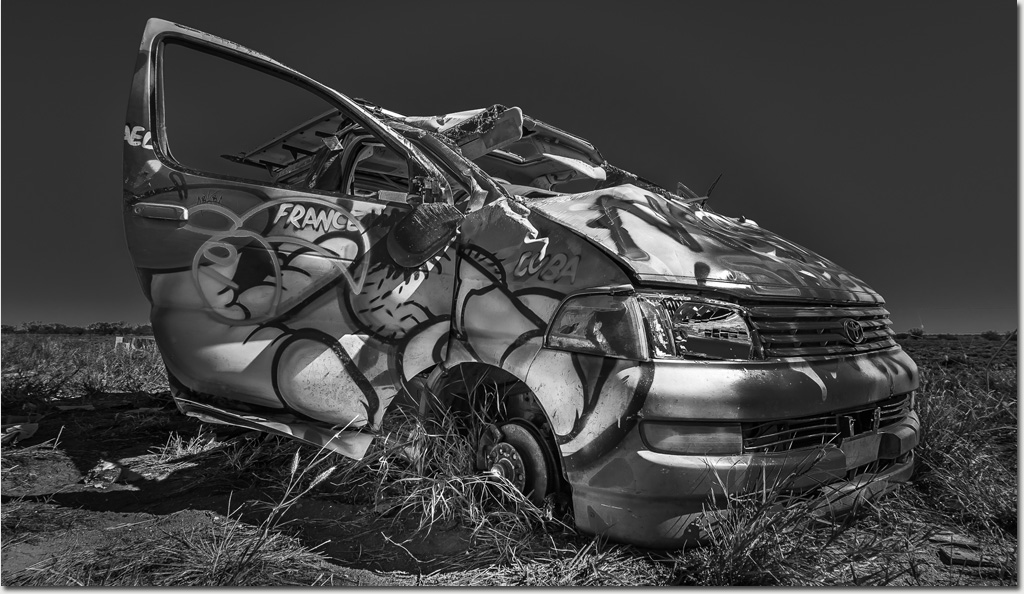
It's a long, long drive between Adelaide and Alice Springs and hundreds of kilometers of perfectly good road can become treacherous when you travel too far and for too long in one sitting.
When we first came across this wrecked Wicked Camper van somewhere near Coober Pedy my heart was in my mouth for fear we had stumbled on something horrible.
From the road we could see the brightly coloured van amid a trail of debris and from here there were no clues if this had just happened or it had been here a while.
Soon it became evident this wreck had been here for some time though I could not help but feel for the occupants, hope that no one was badly hurt and that somehow they resumed what should have been an amazing Australian adventure.
We had indeed stumbled on something horrible. Our distress however pales into insignificance compared to what had happened in those few desperate moments no one ever wants to experience.
Photo: Robert Rath, 'The End of a Wicked Camper' 1/250s f/8 ISO100
15mm
Sunday, October 23. 2016
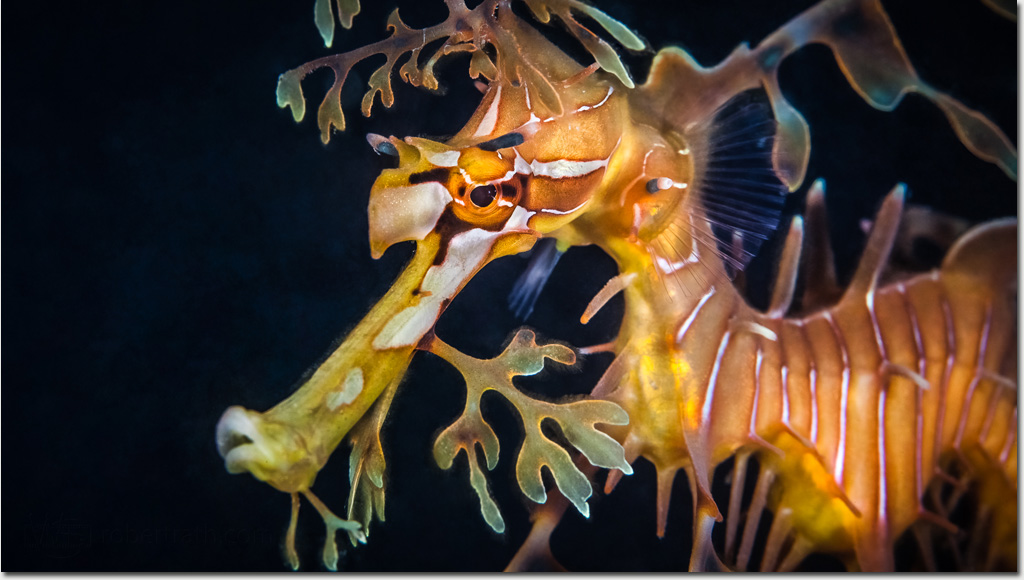
No matter how many times I make the trip down to Rapid Bay Jetty, gear up and head out I never take for granted the joy of finding a dragon.
If and when I find one I experience a curious mix of excitement, of gratitude, of humility, of privilege, of wonder and of complete captivation.
The long drive to get here is forgotten.
The equipment needed to survive here is forgotten.
The burdened walk to the water is forgotten.
The biting cold of an extended winter is forgotten.
The cares of work, of the world and its demands are all forgotten.
With effortless grace they move with precision. It is almost impossible to see the tiny movements which push them through the water.
Spend time with them and you will discover moods and attitudes and personalities.
Take your eyes off them for just a moment, look back and like magic there is is only algae and water and the dappled light from above.
I don't always find a leafy seadragon when I dive here at Rapid Bay but when I do it makes all the effort of every dive I have ever done worthwhile.
Like some lifetime within a lifetime I will spend all the time my air allows to remain here and bear witness to this beautiful fragile creature.
Photo: Robert Rath, 'Seduced by a Dragon' 1/160s f/13 ISO320 100m
Tuesday, October 18. 2016
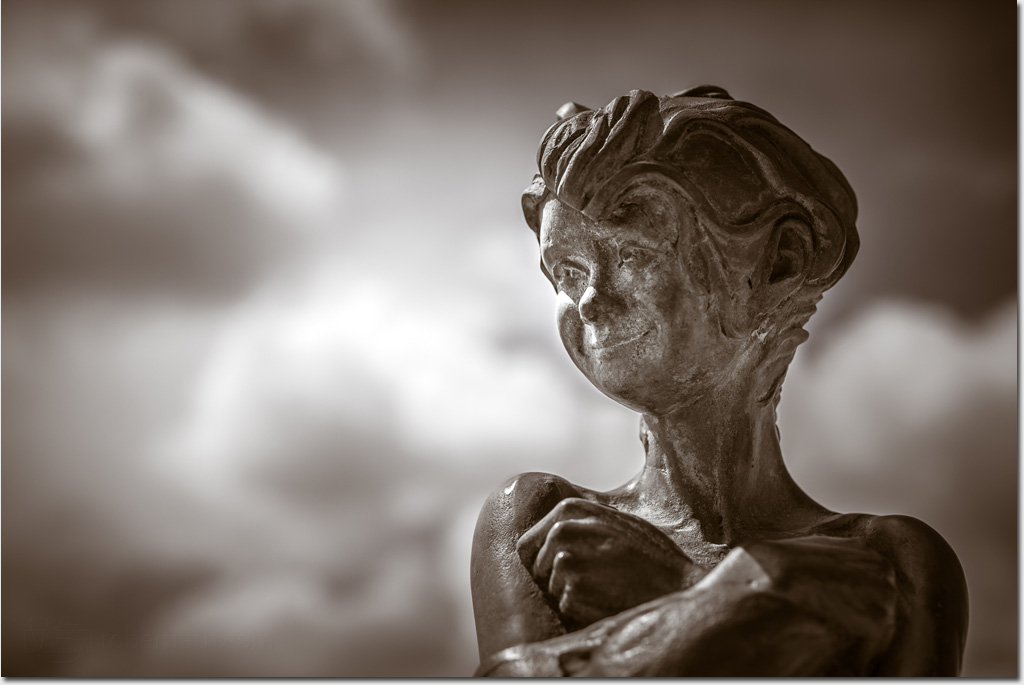
When is a fish not a fish?
When Lucy Dugan wrote about 'fish' she described a dad's affection for his daughter as 'the catch of the day'.
When Nicole Mickle brought her 'fish' into life like bronze relief the expression was just as obscure.
So here she is, a little 'fish' at the head of Busselton Jetty, gazing out into the ocean onto the playground she cherished.
Perhaps she's not a fish after all but a 'selkie' who'll one day head back out to sea, breaking hearts as she goes, never to return again.
Photo: Robert Rath, 'Fish' 1/8000s f/2 ISO100 50mm
Friday, October 14. 2016
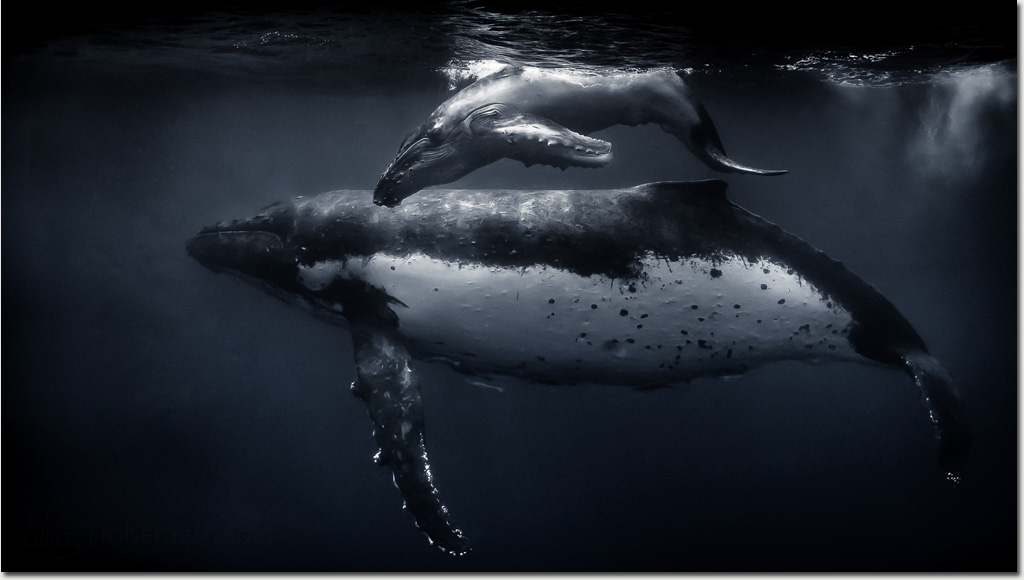
There is no doubt at all in my mind that there is more here than the instinctual caring for a newborn child.
I watched her for a time and was enchanted by the way she nudged and guided and snuggled and swam with her beautiful baby.
In those privileged moments I fell in love with something strange and wild and so beautiful out here in this vast ocean.
These two extraordinary creatures showed me that deep binding love is not just a human thing but part of their world too.
Photo: Robert Rath, 'Love Take all Forms' 1/500s f/8 ISO320 15mm
Tuesday, October 11. 2016
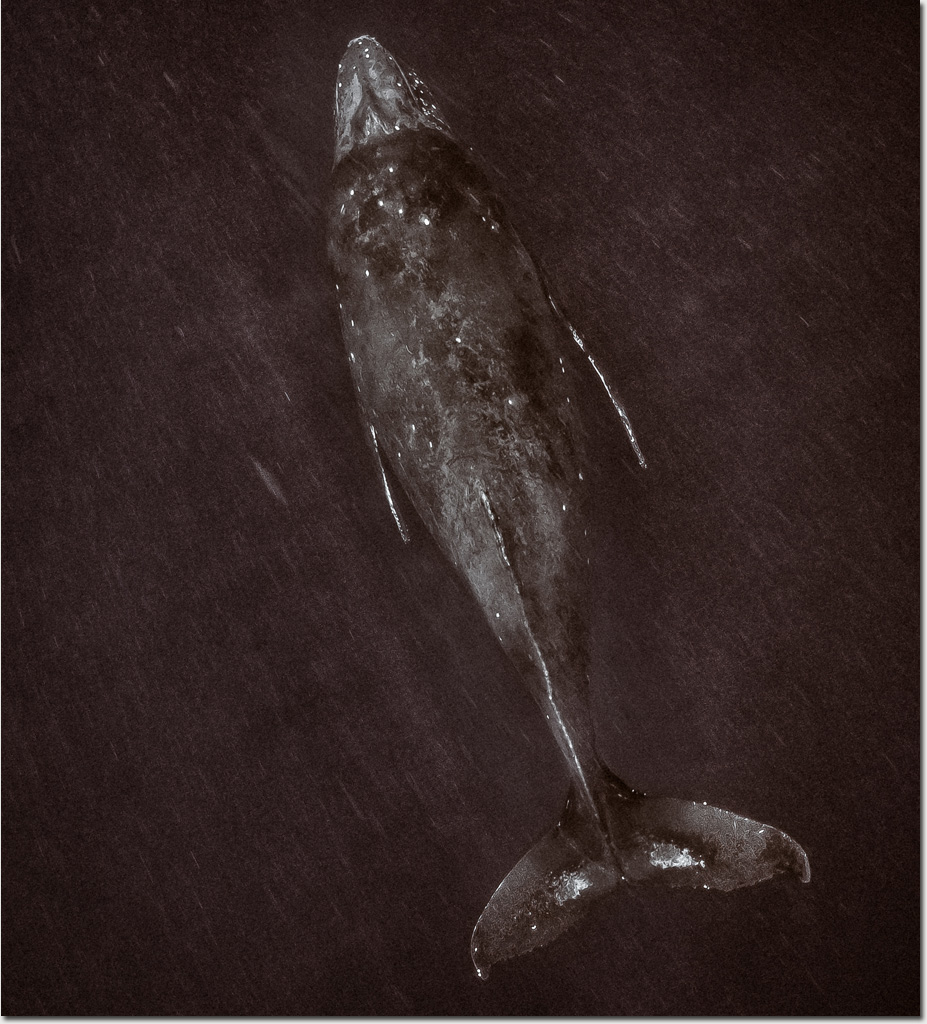
Many of our encounters with these beautiful creatures were very fleeting.
Despite their size humpback whales are very fast and very agile when they want to be. It is often quite deceptive just how fast they really are moving.
This young male, like many others was not interested in spending time lolling on the surface with the little ungainly creatures we all must have seemed like. This time however I took up the challenge and dove in pursuit.
Although he was moving fast, very fast, an amazing thing happened as I neared.
There was no slowing in our pace however the effort to keep alongside simply melted away as I was captured in his watery slipstream.
What seemed like minutes we swam at speed, my dolphining to his barely perceptible movements yet below the ocean floor race by.
At last, my breath exhausted I broke away to return to the surface and in a moment he was gone.
Photo: Robert Rath, 'Slipstreaming' 1/30s f/7.1 ISO160 15mm
Saturday, October 8. 2016
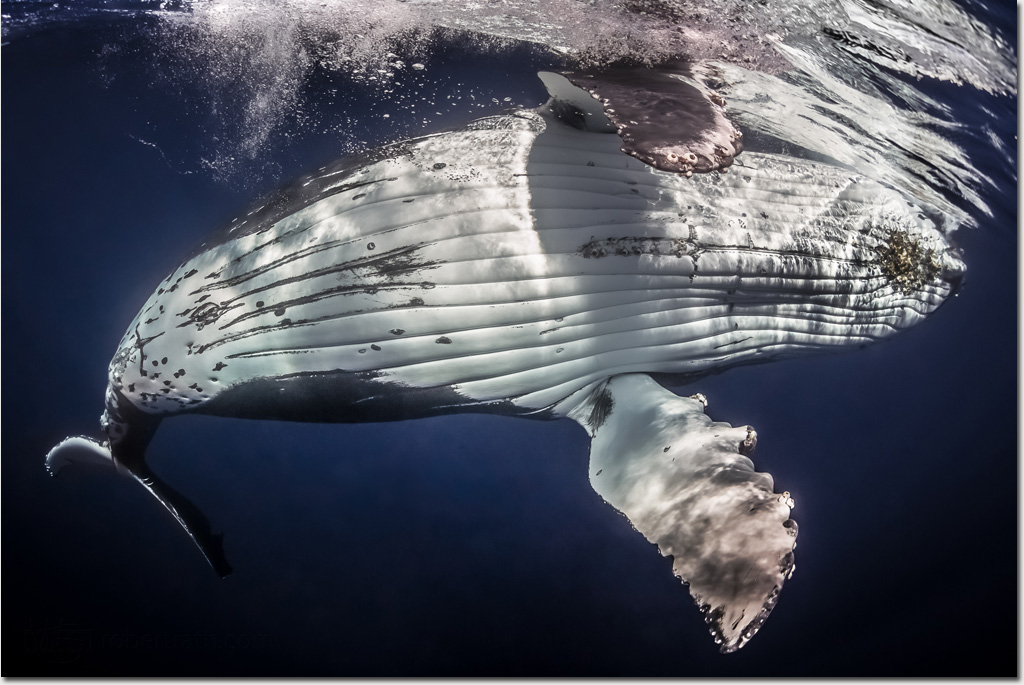
Like a puppy dog he rolled over and over with joyful abandon. You could almost feel the whale speak, 'scratch my belly'.
There was absolutely no doubt that he loved our attention and we all loved his even if it was a little scary and intimidating at times.
Our experience with George off the island group of Vava'u in Tonga was the most extraordinary privilege and something I will never forget.
I hope someday I get the chance to come back here and scratch George's belly again.
Photo: Robert Rath, 'Scratch My Belly' 1/640s f/7.1 ISO160 15mm
Thursday, October 6. 2016
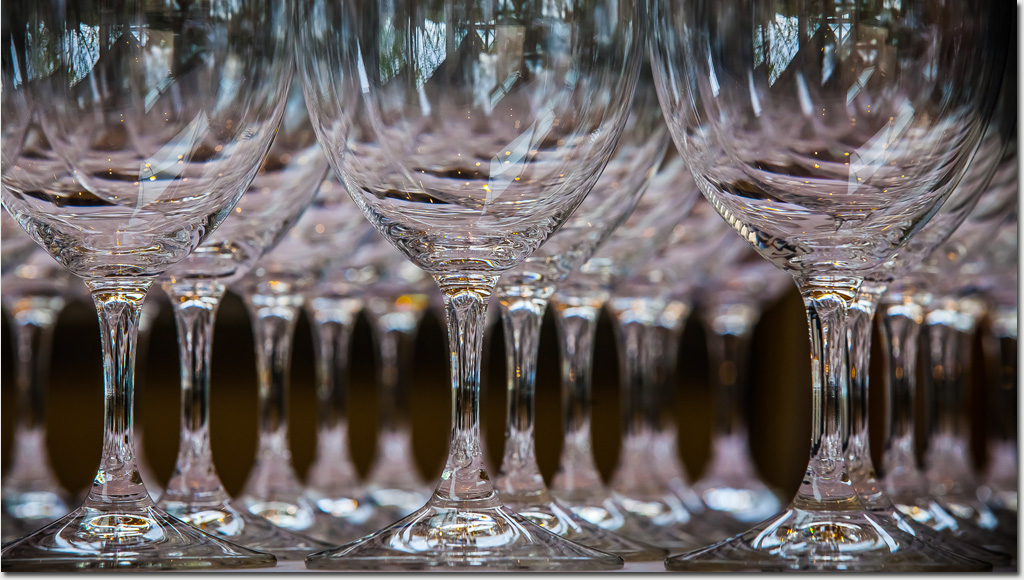
Over the course of the evening this beautifully structured array of crystal glass will first disassociate among guests.
Will be filled and emptied many times with Pinot, Mataro, Grenache and Shiraz.
Some will see water and some will see whites and who know what else before the night is over before finding their way back into a common structure again though most crimson soiled.
They will travel home together,
be cleaned together,
be stored together,
then travel together.
Once again they will find themselves in a beautifully structured array of crystal glass.
Photo: Robert Rath, 'Liquid Geometry 1/100s f/9 ISO800 165mm
Wednesday, October 5. 2016
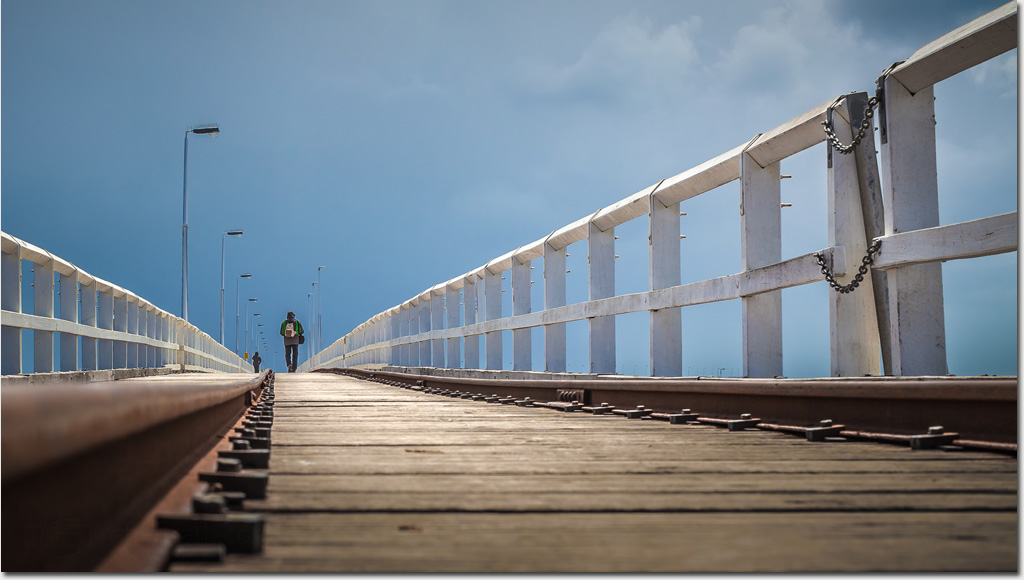
This walker will have walked more than three and a half kilometers by the time he returns from his stroll to the end and back.
At nearly two kilometers, Busselton Jetty is the longest wooden jetty in the world and a drawcard to this region three hours south of Perth.
I dived here more than twenty years ago but unlike our local jetty dives, the only sensible way to get to the end of the jetty is by boat.
I don't really remember much about what we found here beneath the waves so long ago. I think I remember seahorses. I certainly remember many of fish species here were the same as those back home.
I am certain no one was diving here today with turbid cappuccino water crashing around the pylons and onto the beach.
Perhaps this guy is a diver making the longest walk to the end and back instead.
Photo: Robert Rath, 'The Longest Walk' 1/250s f/10 ISO100 50mm
Tuesday, October 4. 2016
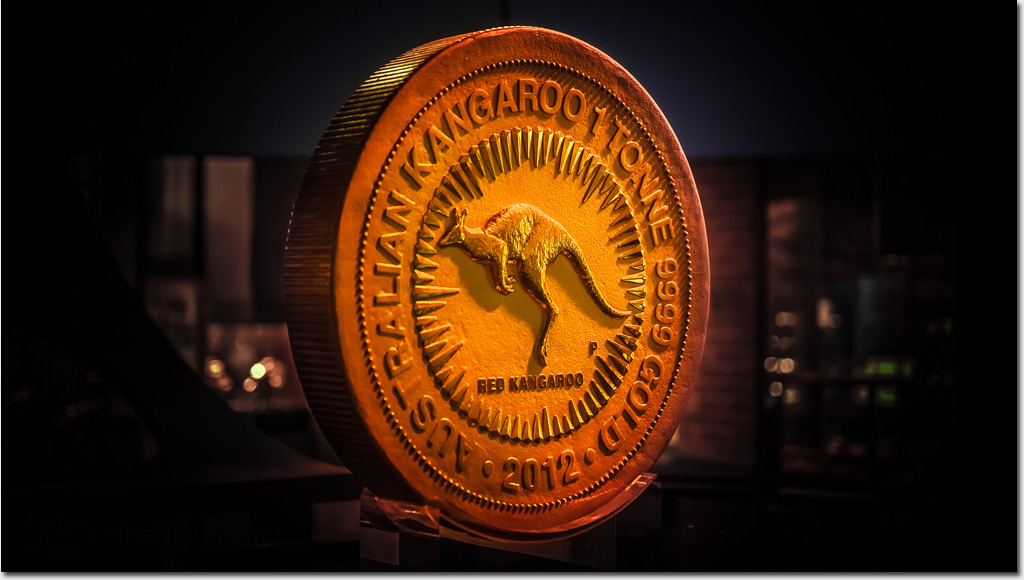
Australia has a bit of a reputation for having some of the 'Largest' things in the world.
Often these are kitsch representations of some local industry or icon like 'The Big Pineapple' or 'The Giant Koala; you get the idea.
When I was told I was about to see the worlds largest coin (legal tender) in the Perth Mint I was not expecting what I was about to see.
One thousand kilograms of 99.99% pure gold crafted into a single legal tender coin with a face value of one million dollars and a true gold value well over $54,000,000.
I considered for a moment if there was a way I might roll it out of there but suspect its shear weight is all the theft protection it needs.
Australia might have a lot of kitsch 'Big' things but this coin is not one of them.
Photo: Robert Rath, 'One Million Dollars' 1/80s f/1.4 ISO2500 50mm
Monday, October 3. 2016
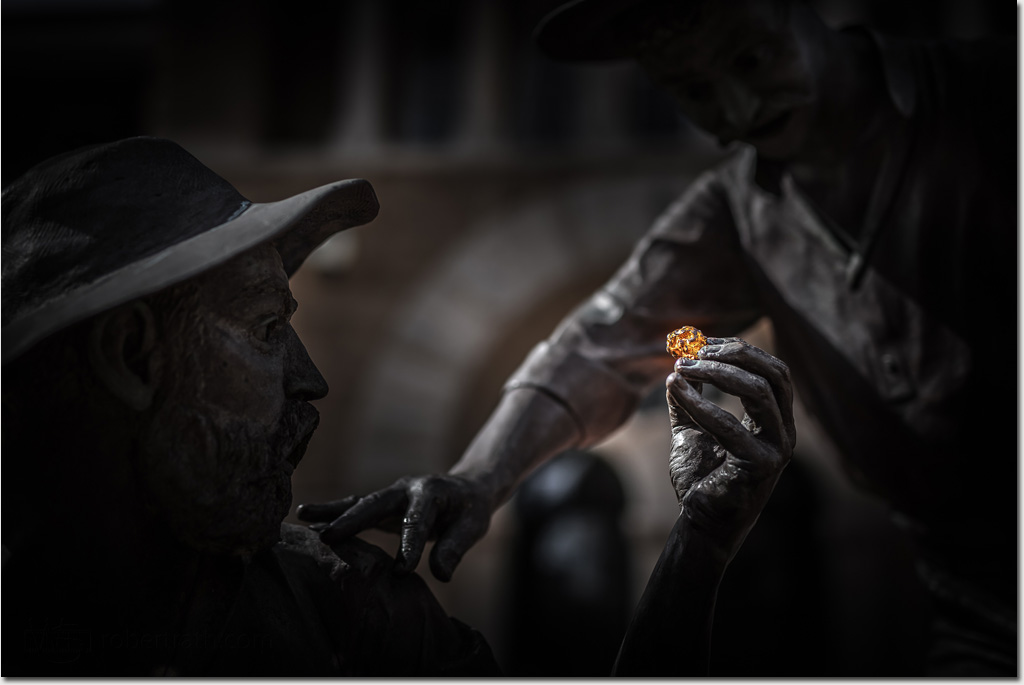
In 1892 William Ford and Arthur Bayley had been prospecting near the Western Australian country town of Coolgardie.
Their story tells how one evening their bush camp was swept away by a flash flood. In their dismay, vowing they'd had enough, they searched for all their scattered belongings with the intention of quitting.
In their searching amid the freshly exposed ground they discovered gold. A total of 16kg of gold for two men who had given up all hope.
William and Arthur are officially credited with starting the first Western Australian gold rush and this statue, sculpted by Western Australian artist Greg James, stands outside the Perth Mint in tribute to their 'strike' and the ensuing wealth for the state of Western Australia.
Photo: Robert Rath, 'The Strike' 1/3200s f/1.8 ISO100 50mm
Tuesday, September 27. 2016
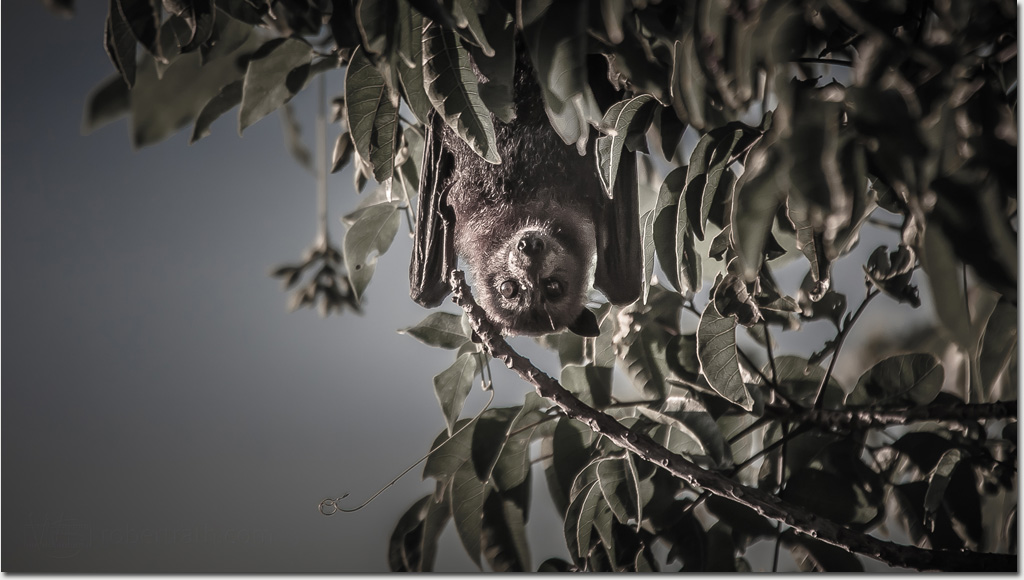
There were no belfries anywhere in sight but that did not stop the fruit eating, wing flapping, throat screeching foxlike locals from taking up residence in the tree next door.
For the most part they were good neighbors, kept the music down, their garden tidy and were not partial to dropping burnouts in the street or even encouraging such behavior.
For most part we lived harmoniously as good neighbors might; until ... a fight broke out.
You could tell the signs well in advance as one bat happily supped nectar another would start to taunt.
First there was the inconspicuous upside down and sideways shuffle getting almost shoulder to shoulder before a sharp wack of a wing sent the offender off in a screech.
The second time the screeching began even before they could swipe each other. An exchange of wing wacks ensued leaving the defender hanging and the offender flapping madly in thin air.
The third time it was all out war with screeching and flapping and leaves flying.
Then like magic they both find their own nectar laden flowers and settle down as if nothing ever happened.
That would not have been so bad if it had happened only once, twice or a handful of times.
Instead, we had a hundred fruit bats squabbling over and over for an hour or more as afternoon turn to dusk.
Then as night fell all became silent.
They were good neighbors after all.
Photo: Robert Rath, 'Just Hanging' 1/100s f/4 ISO160 280mm
Monday, September 26. 2016
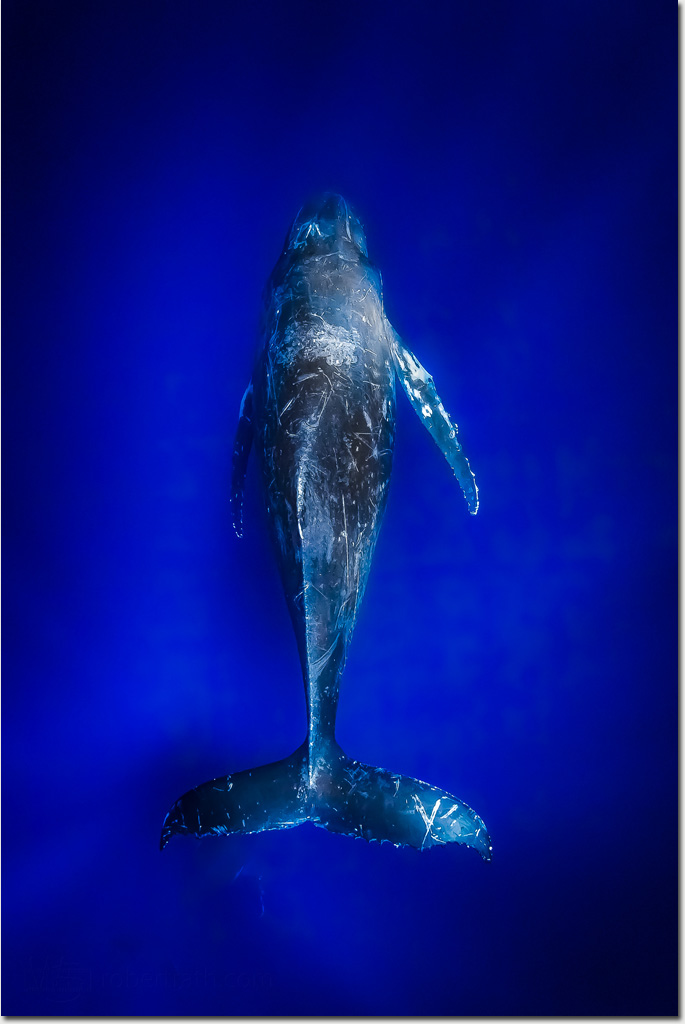
There is a blue out there in the open ocean that can't be described. When that black water is filled with a luminous glow, the bright sunlight reflected by millions and millions of tiny particles suspended.
That blue glow, softly caressing, beguiling, comforting me, encouraging me to follow, down and down and down to follow these gentle beasts as they dive.
The ache in my lungs forgotten, the pressure in my ears ignored, that gentle blue glow, that hypnotic blue glow, like a siren's song begs me follow as the gentle beasts descent below.
Softy at first, then louder and louder like Cloister Bells in the halls of Gallifrey a warning sounds. This beautiful blue place is not all it seems having drawn me down here to a depth I should not be.
I look up but all that I see is that gentle blue glow, every direction that gentle blue glow and those warning bells louder and louder.
The enchantment broken, the whales now gone, alone in this luminous blue I start the long swim back to the surface again.
Photo: Robert Rath, 'Into The Blue' 1/320s f/7.1 ISO160 15mm
Sunday, September 25. 2016

Everything we see around us is relative to everything else we see around us. Small is smaller than big, huge is bigger than large and minuscule is smaller than tiny.
All meaningless really without the context of everything we are comparing everything else with.
To me this makes macro images so interesting because our whole paradigm of comparison becomes useless.
When I look at an image created under a microscope my mind desperately tries to relate what is sees to things we know. More often than not I see things that match objects I am more familiar with.
In this case I however I have the upper hand. I observed my subject from a distance in the world of 'the normal', swam up close to it (there's a hint for you) then photographed a small part in macro.
Of course its a collection of orange pebbles in rice, ... or is it?
Photo: Robert Rath, 'Orange Pebbles in Rice' 1/160s f/22 ISO320 100mm
Saturday, September 24. 2016
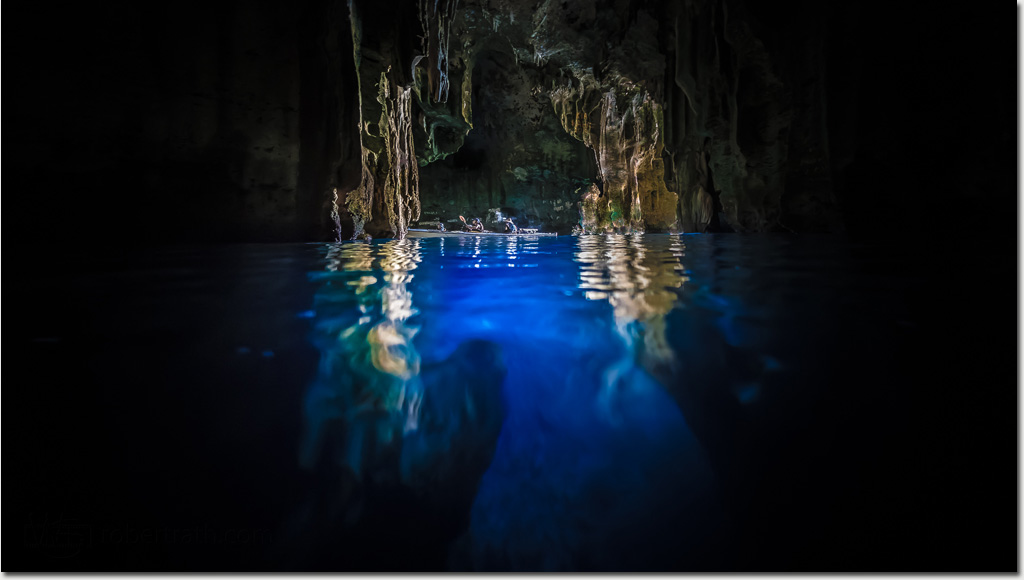
I'm not the only one drawn to the mystery of the nooks and crannies of the world.
Just like me these paddlers want to know what's inside Swallows Cave.
Just like me the darkness piques their curiosity, leads them to explore the cracks and the fissures and the places the light can't reach.
A short while later, when they had seen all they thought there was to see they paddled back out into the stark sunlight again.
What's curious is they never saw me floating here in the watery darkness observing their explorations.
I wonder what else is down here, never seen, observing all of us.
Photo: Robert Rath, 'Watery Grotto' 1/30s f/3.2 ISO1600 15mm
Friday, September 23. 2016
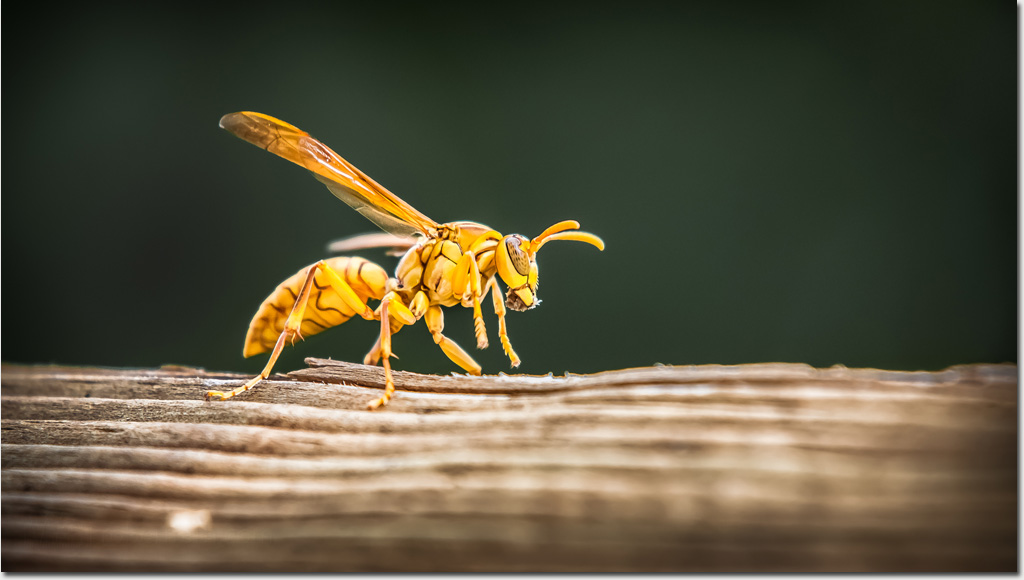
We came across a few of these Yellow Paper Wasps, Polistes olivaceus, while in Tonga.
A couple hung around our house, often cruising through the un-shuttered kitchen before heading out into the trees again.
I do wonder how they came to be here. Did they hitch-hike on some vessel or were they blown by the winds from mainland Asia to finally make a home here.
Next time I meet an entomologist I will remember to ask how far flying insects can travel and maybe shed a little light this one's story.
Photo: Robert Rath, 'Yellow Paper Wasp' 1/160 f/7.1 ISO400 280mm
|